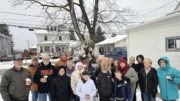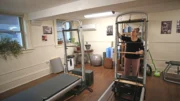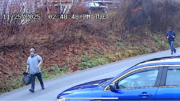Oil City officials are contemplating whether to redevelop or rehabilitate the blighted East End of Oil City.
The subject was discussed at length during Wednesday’s Oil City Redevelopment Authority meeting as Bill Fontana, the director of strategic initiatives for the Pennsylvania Downtown Center in Harrisburg, presented the results of a detailed study of blighted properties on the East End.
The properties were evaluated from the street by Keystone C.O.R.E. Services during the summer and fall of 2020 using the standards of the 2015 International Property Maintenance Code, which Oil City uses for its evaluations.
The area evaluated in the study runs from Wilson Avenue to the city line at the bottom of the Seneca Hill and from Route 257 to East Third Street, according to the report. It encompasses East Second, East Third, Pine, Walnut, Church, Imperial, Liberty and Grant streets, Wilson, Allegheny and Pennsylvania avenues, and the East Third Alley.
Fontana said the evaluations probably represent a best-case scenario of the condition of the properties as only the exterior that was visible from the road was evaluated and the properties weren’t entered.
He added that some of the roofs and foundations weren’t visible from the street, so they couldn’t be evaluated.
The study was primarily of residential structures as a number of businesses along East Second Street, including the post office, Country Fair, CVS, Rite Aid, Giant Eagle and Villa Italia weren’t evaluated at the request of the city.
“From Wilson to Grant or Allegheny the deterioration was fair to significant,” Fontana said. “As you get down to the southeast corner there is a lot of significant or major deterioration. Coming into Oil City there is a lot of blight,” he added.
Fontana noted that most of the blight is cosmetic. Things that constitute cosmetic blight include paint or steps, porches, decks, windows and decorative elements in poor shape and in need of repair.
“Cosmetic blight is very observable from the street…It looks bad, but it can be addressed and it is not unsalvageable,” Fontana said.
In contrast, properties with structural blight have issues such as cracks in the cement blocks or stones that make up the building’s foundation, and sagging roofs and walls that are beginning to bow and may need to be considered for demolition.
“Some properties warrant demolition, but most can be addressed (for rehabilitation),” Fontana said.
On a positive note, Fontana said there is some evidence of recent rehab efforts — numerous homes with new metal roofs, some with new windows and some with porches and stairs that have been worked on.
He also encouraged the city not to wait too long before addressing blight concerns as there are many issues that will only get worse with time. He said more funding is being made available over the next two years.
To move forward, Fontana said a community consensus must be reached as to whether redevelopment or rehabilitation is the best mitigation approach. He said the character of the area must be decided, not merely what improvements should be made.
“You have to come to a deal, are you going to make things the best for the people that live here or draw in more people,” Fontana said.
He noted a consensus must also be reached as to the residential and commercial character of the East End neighborhoods.
Discussion after the presentation by those in attendance didn’t produce a consensus.
Oil City Council member Ron Gustafson and Redevelopment Authority member Alan Shiller said an area along East Second would be a good place to redevelop with more stores.
Bailey and Redevelopment Authority member Maureen James expressed concern that expanding commercial development to the East End would compete with business in the downtown and spread businesses over a larger area, thus “diluting” them.
Fontana repeatedly recommended that a complete market assessment of the area should be done to show what kind of businesses the area can support, what is already there and where there are gaps.
He cautioned that opening up East Second Street as a business corridor might compete with the downtown or other business areas, shifting existing businesses around instead of bringing in more.
A buy up, tear down and rebuild approach such as was more common in the 1960s and later will “cost an arm and a leg” today, Fontana said. He added that many government funds available for redevelopment decades ago have dried up.
“Old style redevelopment is extremely expensive in this day and age. Every property has to be appraised and acquired for fair market value. Moving assistance must be provided as well as help finding a new place,” said Fontana, who worked in economic development in Allegheny County for 17 years.
Another alternative is the rehabilitation of existing structures. Fontana said many of the issues in the East End can be addressed through rehabilitation and code enforcement.
Fontana discussed a number of government grants and programs for blight mitigation and other community development projects that the city may be able to tap into if it wants to rehabilitate the existing neighborhood.
He also noted that aggressive code enforcement in the area and the use of conservatorship or drug nuisance laws on properties that are problematic and receive a lot of police calls would “send a message” that the game is changing.
“You didn’t get into this situation overnight, you won’t get out of it overnight. This was 40 years in the making. You can make significant progress in five to seven years,” Fontana said.

































